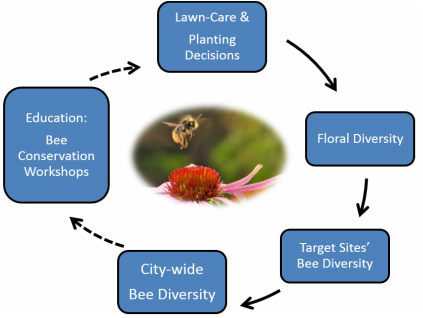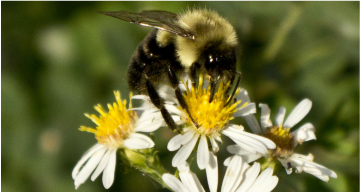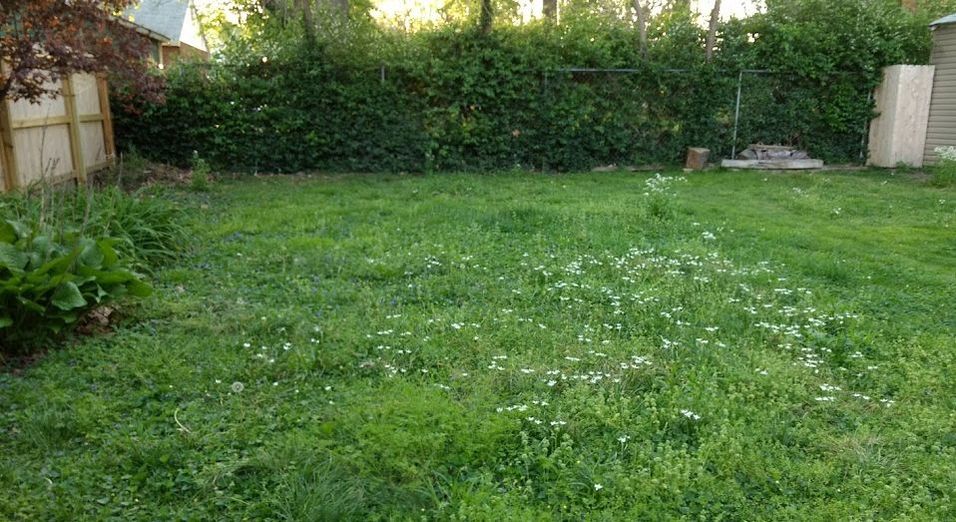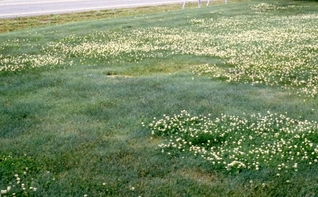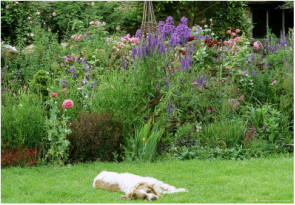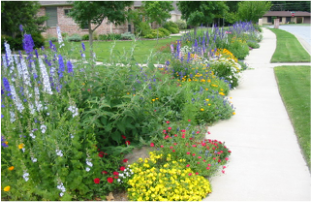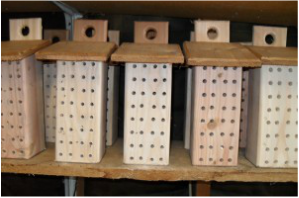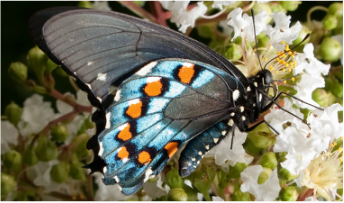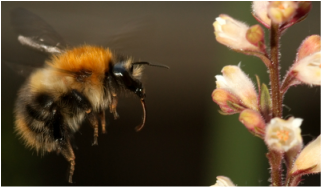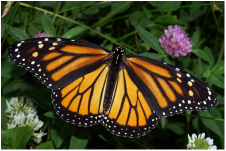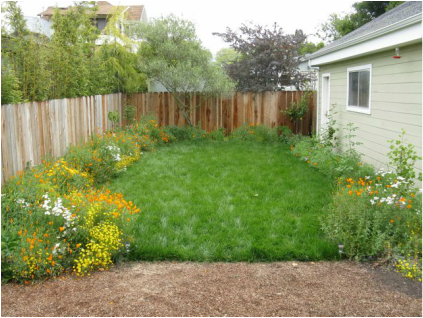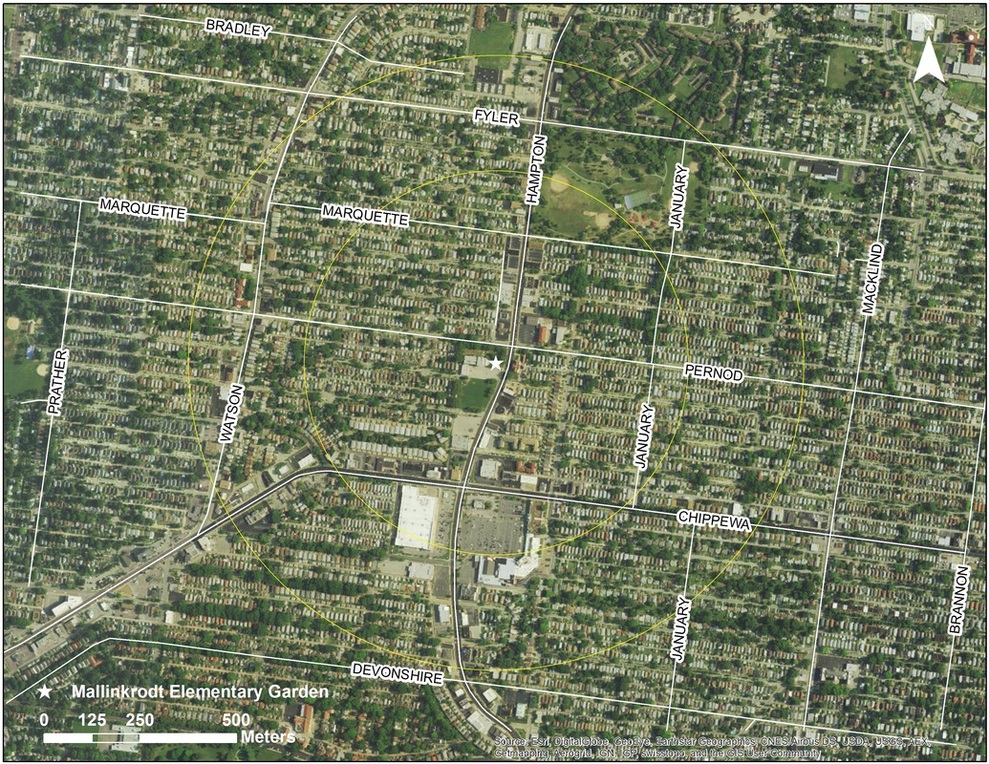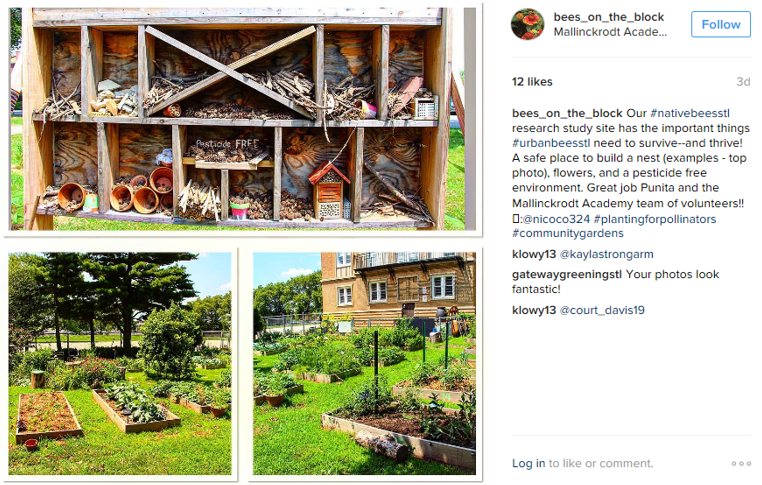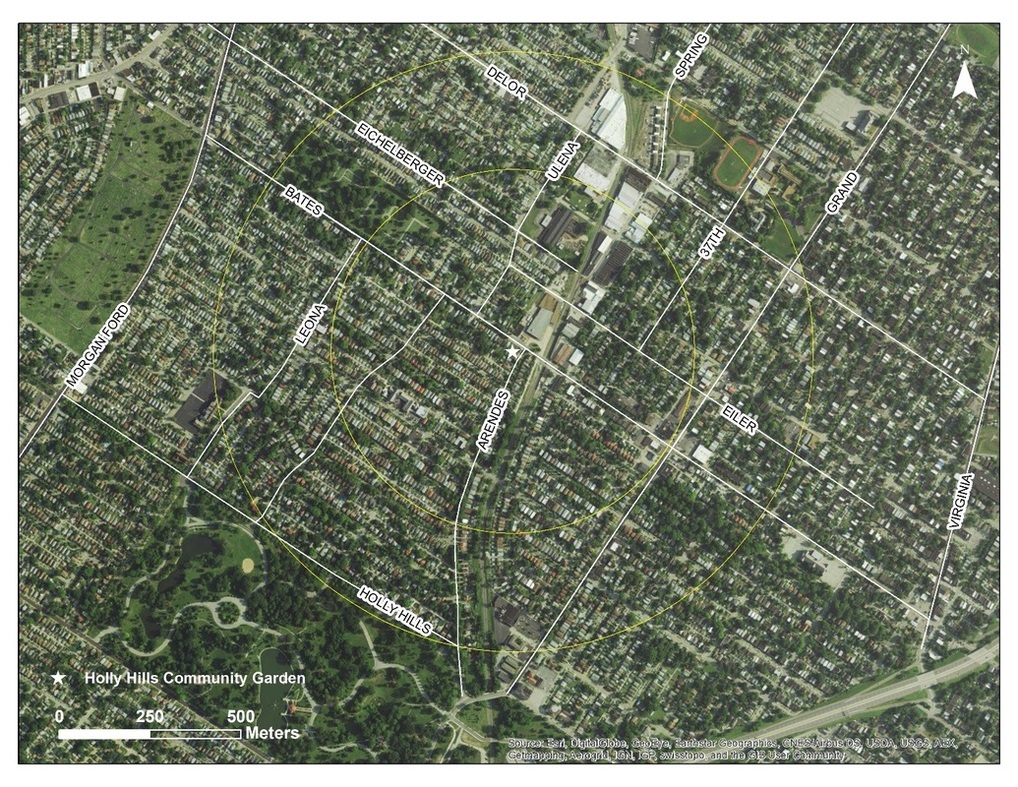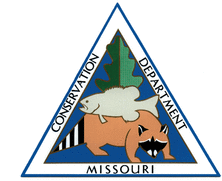Project Description: |
This was a two-year study being conducted by Saint Louis University with support from Missouri Department of Conservation in St. Louis' 23rd Ward and Holly Hills neighborhoods. 2015-2017
|
|
Figure 1. Project hypothesis. Solid lines show known driving factors and dashed lines show information the project team will provide.
With Information about City-Wide Bee Diversity we will host Educational Bee Conservation Workshops to inform your Lawn-care & Planting Decisions. We have seeds, resources, yard signs, and access to experts to help. Lawn-care & Planting Decisions increase Floral Diversity which increases Bee Diversity of Target Sites which increases City-wide Diversity. |
Background:
We are using long-term bee sampling data and science communication to explore: Can communities plant our way out of a pollinator health crisis? What we're doing: Encouraging residents in two St. Louis neighborhoods to increase the number and variety of flowers in their yards, public places, and commercial properties to help urban bees. How we will know it's working: We are sampling bees weekly at the sites to monitor any measurable increases in bee species diversity and abundance (metrics of bee health) due to increased bee habitat. These 2 neighborhoods: were selected as project sites because they have the lowest numbers of unique bee species of any of our 30 sites. This means they are well-positioned to have the greatest measurable increases in species due to voluntary management changes. |
What to Do: Listed from highest impact
1. Plant Flowers, shrubs, & trees that Attract Bees & Butterflies
The best predictor of bee and butterfly health (abundance & diversity) is number of flowers.
A variety of flowers that bloom throughout the season are best
Early blooming flowers are critical for determining how many offspring native bees have per year.
Plant Lists for St. Louis- Show these lists to your garden center staff.
- Selecting Plants for Pollinators - Pollinator Partnership
- Pollinator Plants List Midwest- Xerces Society
- Sortable Midwest Pollinator Plant List- Lady Bird Johnson Wildflower Center
- Phone App for Android & IOS: BeeSmart Pollinator Gardener Pollinator Plant Finder, sortable
- Missouri Botanical Garden -MOBOT Plant Finder - to see what the recommended plants look like.
Plant Lists with Advice for Planting & Landscape Design
- Native Plants for Attracting Pollinators- Missouri Dept. of Conservation (landscaping design tips)
Additional Resources from trusted Sources
- Missouri Resources- Xerces Society
2. Mowing: less = more flowers
|
3. Mulching: less = more nest sites
|
|
In addition to planting flowers, studies have shown that mowing your grass less frequently increases the number of bees visiting your yards flowers found in older grass mixes.
One study (Lerman et al. 2018) found: Mow one every week: 0% increase Mow once every two weeks: 60% increase in number of bees Mow once every three weeks: 300% increase in number of bees We have yard signs available (free) for those who want to communicate to their neighbors that they are mowing less this year for the health of bees and to help with our study. Tell us if you want a sign in the comment box below. Bottom line: Mowing less = More flowers |
A majority of bees are ground-nesting bees.
They require bare un-mulched soil to reproduce offspring. One study found: Gardens with less mulched area had more diverse species of bees. Less mulch = more bees Leave some bare ground near plants you want pollinated. Leave bare ground in areas that get little foot traffic. Bottom line: Mulching less = More sites for ground nesters |
4. Bee Condos & Keep Native Bees |
Notes on Native Bees
|
|
For those who want to create nesting habitat for cavity nesting bees, making "bee condos" is simple. Drill holes into a block of wood, fallen log, or dead tree stump.
1/4" or Smaller holes = 3" to 5" in length 1/4" or Larger holes= Greater than 5" in length Line the hole with paper. See this 4 min. video for more tips. Our favorite videos: Building a bee condo. To see a Bee Condo in action. Nests for native bees- from Xerces Tunnel Nests for native bees- from Xerces Experienced woodworkers: Send us your pics of bee houses, bee condos, etc. |
Difference between Native bees & Honeybees:
The Bee Chronicles 2 Stinging: All bees do not sting—less than half of all bee species sting. Of those, only females have stingers and among those, not all have a hive or colony to defend. Bees will always be more interested in pollinating flowers than bothering to sting you. For more: Myth:All Bees Sting Inviting Bees to Your Property: Pollinator Partnership |
Workshop Slides
|
Download Slides Here ----->
View Slides Below. |
| ||
Workshop Transcript
|
Download Slides Here ----->
View Transcript Below. |
| ||
Two Ways to Contact Us:
Pollinator-friendly gardens attract pollinators. For example, I surveyed bees on green roofs and in city parks in Chicago. I collected a new bee species to Illinois (a new state record!) from the middle of Millennium Park in the Lurie Garden, which is full of beautiful native prairie plants... |
Study Site Maps:
If you live or work within the circles, we need your help.
Project Site 1: Ward 23
Tilles Park Neighborhood, Lindenwood Park, Northampton, & Southampton
Send us your yard pictures!
|
Pollinator-friendly Yards of Ward 23Your Ward 23 pictures here.
|
Ward 23 Project Flyer |
| ||
Project Site 2: Holly Hills
|
Send us your yard pictures!
Email to [email protected] |
Pollinator-friendly Yards of Holly Hills.Your Holly Hills pictures here.
|
Holly Hills Project Flyer |
| ||
Press |
NewsWorks.org- "Wild bees are trading in rural life for the big city" 5 Jan 2017
http://www.newsworks.org/index.php/thepulse/item/100157-wild-bees-are-trading-in-rural-life-for-the-big-city
St. Louis Public Radio- "SLU scientists study wild bees to learn why they prefer cities as habitats" 29 Oct 2016
http://news.stlpublicradio.org/post/slu-scientists-study-wild-bees-learn-why-they-prefer-cities-habitats#stream/0
Science Daily- "Cities can serve as a refuge for insect pollinators" 3 Oct 2016
https://www.sciencedaily.com/releases/2016/10/161003104133.htm
Phys.org - "Scientists show cities can serve as a refuge for insect pollinators" 30 Sept 2016
http://phys.org/news/2016-09-scientists-cities-refuge-insect-pollinators.html
GrowerTalks Magazine. "The city as a refuge for insect pollinators"18 November 2016.
http://www.ballpublishing.com/newterrain/Newsletter.aspx?article=2095
NewTerrain “The city as a refuge for insect pollinators.” 15 Nov 2016
http://www.newterrain.us/urban-ecology/the-city-as-a-refuge-for-insect-pollinators/
http://www.newsworks.org/index.php/thepulse/item/100157-wild-bees-are-trading-in-rural-life-for-the-big-city
St. Louis Public Radio- "SLU scientists study wild bees to learn why they prefer cities as habitats" 29 Oct 2016
http://news.stlpublicradio.org/post/slu-scientists-study-wild-bees-learn-why-they-prefer-cities-habitats#stream/0
Science Daily- "Cities can serve as a refuge for insect pollinators" 3 Oct 2016
https://www.sciencedaily.com/releases/2016/10/161003104133.htm
Phys.org - "Scientists show cities can serve as a refuge for insect pollinators" 30 Sept 2016
http://phys.org/news/2016-09-scientists-cities-refuge-insect-pollinators.html
GrowerTalks Magazine. "The city as a refuge for insect pollinators"18 November 2016.
http://www.ballpublishing.com/newterrain/Newsletter.aspx?article=2095
NewTerrain “The city as a refuge for insect pollinators.” 15 Nov 2016
http://www.newterrain.us/urban-ecology/the-city-as-a-refuge-for-insect-pollinators/
